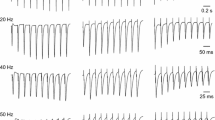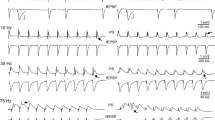Summary
Long term potentiation (LTP) in response to brief high frequency trains has been reported for many pathways in the hippocampus. The mechanisms involved are still unclear. The present experiments set out to confirm reports in the literature that LTP of output from CA3 neurons can be specific to particular collaterals. Single pulses delivered to area CA3 produced field responses nearly simultaneously in area CA1 and in the lateral septum (LS). High frequency stimulation of CA3 produced long term potentiation of CA1 but not LS responses. The CA1 response to stimulation of the contralateral hippocampus did not potentiate when the CA1 response to CA3 stimulation showed long term potentiation. The CA1 and LS responses to CA3 stimulation showed similar strength-duration, strength-amplitude and frequency following characteristics. Their latencies were comparable to the latencies of antidromic activation of CA3 cells from CA1 and LS. Movement of stimulating electrodes to the region of the Schaffer collaterals increased the latency of the LS response and decreased the latency of the CA1 response but left the sum of these latencies unchanged. It was concluded that the CA3 and Schaffer stimulation were activating LS and CA1 collaterals of the same CA3 neurons. CA1 and LS responses to CA3 stimulation showed somewhat different paired pulse and frequency potentiation characteristics. These data confirm reports in the literature that long term potentiation is both input-specific and collateral-specific. The mechanisms of long term potentiation are likely, therefore, to be limited to changes at specific synaptic junctions, e.g. changes in sensitivity of specific postsynaptic receptor sites or changes in transmitter release, which can depend on functional or organisational differences between two collaterals of the same neuron.
Similar content being viewed by others
References
Abraham WC, Goddard GV (1984) Asymmetric relation between homosynaptic long-term potentiation and heterosynaptic long-term depression. Nature 305: 717–719
Alger E, Teyler TJ (1976) Long-term and short-term synaptic plasticity in the CA1, CA3 and dentate regions of the rat hippocampal slice. Brain Res 110: 463–480
Andersen P, Bliss TVP, Skrede KK (1971) Lamellar organisation of hippocampal excitatory pathways. Exp Brain Res 13: 222–238
Andersen P, Sundberg SJ, Sveen O (1977) Specific long-lasting potentiation of synaptic transmission in hippocampal slices. Nature 266: 736–737
Andersen P, Teyler T, Wester K (1973) Long-lasting change of synaptic transmission in a specialised cortical pathway. Acta Physiol Scand Suppl 396: 34
Andersen P, Silfvenius H, Sundberg SH, Sveen O, Wigstrom H (1978) Functional characteristics of unmyelinated fibres in the hippocampal cortex. Brain Res 144: 11–18
Bliss TVP (1979) Synaptic plasticity in the hippocampus. TINS 2: 42–45
Bliss TVP, Lomo T (1973) Long lasting potentiation of synaptic transmission in the dentate area of the anaesthetised rabbit following stimulation of the perforant path. J Physiol 232: 331–356
Gottlieb DI, Cowan WM (1973) Autoradiographic studies of the commissural and ipsilateral association connections of the hippocampus and dentate gyrus of the rat. I. The commissural connections. J Comp Neurol 149: 393–422
Hjorth-Simonsen A (1973) Some intrinsic connections of the hippocampus in the rat: an experimental analysis. J Comp Neurol 147: 145–162
Lynch GS, Dunwiddle T, Gribkoff V (1977) Heterosynaptic depression: a postsynaptic correlate of long term potentiation. Nature 266: 737–739
McLennan H, Miller JJ (1974) The hippocampal control of neuronal discharges in the septum of the rat. J Physiol 237: 607–624
McNaughton BL, Douglas RM, Goddard GV (1978) Synaptic enhancement in the fascia dentata: cooperativity among coactive afferents. Brain Res 157: 277–273
McNaughton N, Miller JJ (1984) Medial septal projections to the dentate gyms of the rat: electrophysiological analysis of distribution and plasticity. Exp Brain Res 56: 243–256
Swanson LW, Sawchencko PE, Cowan WM (1980) Evidence that the commissural, associational and septal projections of the regio inferior of the hippocampus arise from the same neurons. Brain Res 197: 207–212
Swanson LW, Sawchencko PE, Cowan WM (1981) Evidence for collateral projections by neurons in Ammon's horn, the dentate gyrus, and the subiculum: a multiple retrograde labeling study in the rat. J Neurosci 1: 548–559
Voronin LL, Kudryashov IE, Ioffe SV (1974) Prolonged posttetanic potentiation in hippocampus and its connection with conditioned reflex mechanisms. Dokl Akad Nauk SSR 217: 1453–1456: translated in Dokl Biol Sci 217: 375–378
Author information
Authors and Affiliations
Rights and permissions
About this article
Cite this article
McNaughton, N., Miller, J.J. Collateral specific long term potentiation of the output of field CA3 of the hippocampus of the rat. Exp Brain Res 62, 250–258 (1986). https://doi.org/10.1007/BF00238844
Received:
Accepted:
Issue Date:
DOI: https://doi.org/10.1007/BF00238844




